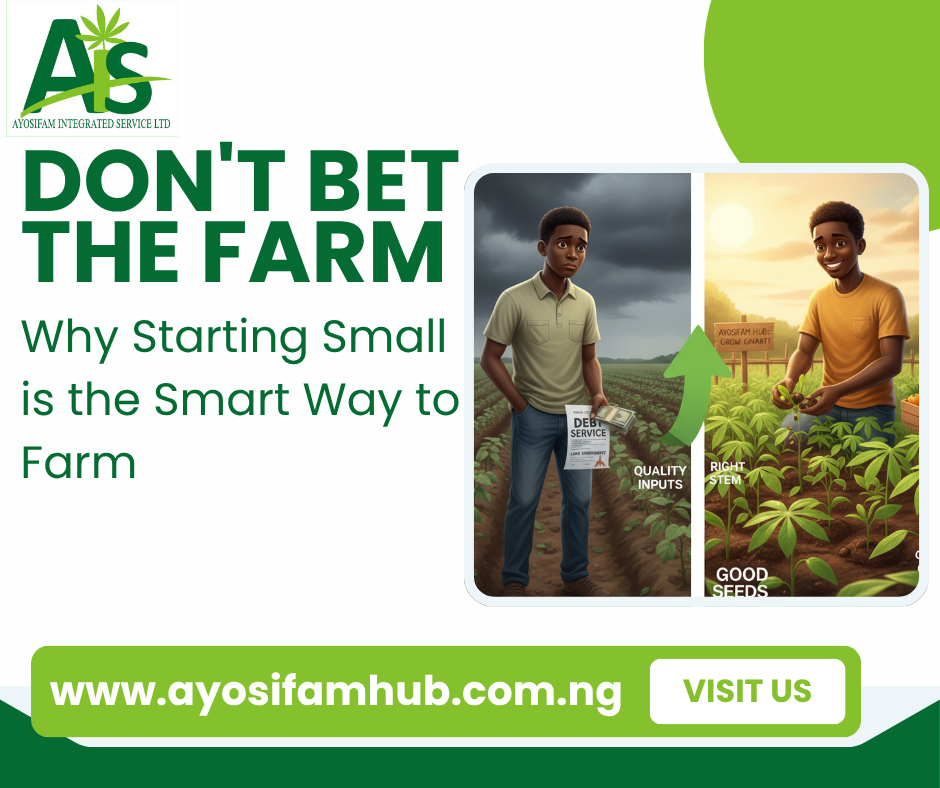Starting a farm can be an incredibly rewarding venture, but many aspiring farmers make a common, critical mistake: they start too big, too fast, often relying on large loans or their gratuity (retirement lump sum). While ambition is necessary, leveraging your entire financial cushion or taking on significant debt at the outset can turn a dream into a devastating liability.
At AyosifamHub, we champion a sustainable, low-risk approach. The wisest path to a successful farming career is to start small, use minimal capital, and focus on quality inputs from day one.
1. The Perils of Debt and Gratuity
Beginning your farm with a substantial loan or by exhausting your gratuity introduces enormous, unnecessary pressure and risk.
A farm loan brings immediate debt service—a monthly repayment obligation that must be met regardless of your farm’s performance. Farming has a steep learning curve and is subject to unpredictable factors: Weather (droughts, floods, or untimely rains can wipe out crops and revenue), Pests and Diseases (an outbreak can decimate your yield), Market Fluctuations (prices for produce can drop unexpectedly), and the Learning Curve (first-time farmers inevitably make mistakes in managing soil, water, or planting times).
When you start small, these risks might mean a lost season; when you start with a loan, they can lead to foreclosure and financial ruin.
Your gratuity or retirement savings are your financial safety net. Dipping into this to fund an unproven business is a high-stakes gamble. If the farm fails—which many new businesses do—you’ve lost not just your venture, but your future security. A successful farm should build your future wealth, not consume your existing reserves.
2. The Power of Starting Small (Bootstrap Farming)
Instead of a multi-acre project funded by debt, the bootstrap farming approach is far more prudent. Start with a small plot that you can manage effectively with a minimal amount of personal savings.
Low-Risk Learning
Farming is learned best by doing. Starting small allows you to: Experiment and Fail Cheaply (make mistakes on a small scale without catastrophic financial consequences), Master the Fundamentals (focus on understanding your local soil, microclimate, and market demand before scaling up), and Manage Resources Wisely (learn to maximize yield from a small space, making you a more efficient farmer in the long run).
Organic Growth and Reinvestment
Your initial capital is used to purchase only the most essential items (seeds, basic tools, minor soil amendments). As you harvest and sell your produce, the profits are reinvested into the farm to fund the next stage of growth. This method ensures that the farm is funding its own expansion, making it inherently sustainable and resilient.
3. The Cornerstone of Success: Quality Inputs
No matter the size of your operation, two things should never be compromised, as they have the largest impact on your eventual yield and profitability:
Always Use Good Seed
Quality seeds ensure more plants actually sprout, maximizing your use of land and time (Higher Germination Rate). Reputable, certified seeds often have genetic traits that make them more resilient to common local threats (Pest and Disease Resistance). Good seeds are bred for high and consistent production, ensuring your harvest is reliable for market (Predictable Yields).
Select the Right Stem (or Variety)
Choose varieties (e.g., of cassava, yams, or fruit trees) that are specifically adapted to your local rainfall, temperature, and soil type (Suitability to Climate). The “right stem” for one region may be a disaster in yours. Also, select varieties that your local market actively wants and pays a premium for (Market Demand). There’s no point in having a bumper harvest of a crop no one is buying.
AyosifamHub’s Bottom Line
Farming is a marathon, not a sprint. Don’t let the promise of a big start push you into a vulnerable financial position.
Start with what you can afford to lose (a small amount of savings), learn diligently, and invest consistently in quality inputs (good seed and the right stem). This patient, sustainable path ensures that when your farm eventually scales, it will be built on a solid foundation of proven methods and sound financial health.
Grow smart, not fast! 🚀




